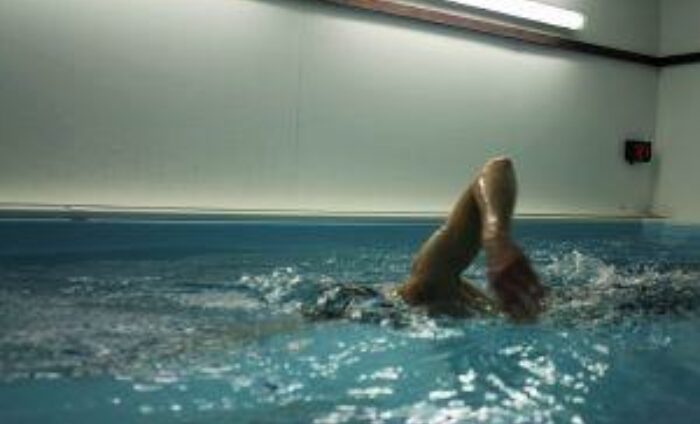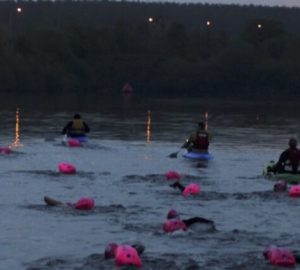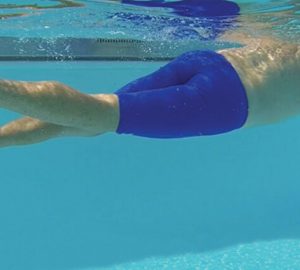
Tips and tricks for bilateral breathing
What is it?
Bilateral breathing is simply breathing to both sides while swimming front crawl. A common pattern associated with bilateral breathing is to take a breath every three strokes. In this case, you would first take a breath to your left, then keep your head down for two strokes before taking a breath to your right. However, this is not the only pattern and the actual pattern used is of less importance than developing the ability to breathe either side and incorporating that regularly into your swimming practice.
Why do it?
In open water swimming being able to breathe either side can help you with sighting (e.g. while swimming parallel to the shore), avoiding breathing into on-coming chop and keeping an eye on competitors on both sides during a race. On long swims there’s also a comfort factor as it adds some variety to your stroke and can help you relax your neck and shoulders. Bilateral breathing also helps with the balance and symmetry in your stroke.
How to do it
If you’re new to bilateral breathing, start small and don’t expect an overnight transformation. Try incorporating breathing to your least favoured side during a warm up or cool down, and try to breathe both sides when doing drills. Experiment with different patterns such as the traditional every three strokes, 3-2-3-2 (i.e. two breaths on one side then two breaths on the other) or alternate lengths breathing first to your left and then to your right. Don’t worry about speed initially.
Practising bi-lateral breathing is actually a great opportunity to review your breathing skills. Try to turn sideways (neither looking forwards or backwards) and avoid lifting your head.
Why you might be finding it hard – and what to do about it
Some swimmers are equally comfortable breathing either side from when they start swimming. Others are totally one sided and can struggle for years with breathing on their less comfortable side, or they just give up. It’s worth persevering, even if you’re never going to use bilateral breathing in a competitive situation. Here are some of the reasons people find it hard.
- Your stroke rate is low: if your stroke rate is low you may not be getting enough air when you switch to a bilateral pattern. If your stroke rate is, say, 45 per minute this means you would get 22.5 breaths per minute when breathing every stroke. If you breathe every three strokes you will be down to 15 breaths per minute – if exercising hard on land we can easily exceed 40 breaths per minute. Try taking more strokes each side before switching (e.g. 3-2-3-2 or 3-2-2-3-2-2 or even 3-2-2-2-3-2-2-2). Even if you have a high stroke rate (80 strokes per minute plus) you may still find that traditional bilateral breathing doesn’t deliver enough air under intense conditions. Again, the 3-2-3-2 pattern will help.
- Your stroke is asymmetrical: a number of swimmers (even some world class swimmers) have a marked asymmetry in their stroke. This asymmetry may be incredibly fast and efficient (e.g. watch Michael Phelps). Trying to breathe using a traditional 3-2-3-2 bilateral pattern will disturb the natural rhythm of your stroke. Instead try breathing to your weaker side on alternate lengths and establish a new rhythm for that.
- You’re under too much pressure: when we’re under pressure while swimming (e.g. when racing or trying to complete a tough training set) we will naturally resort to our most comfortable breathing pattern. This is not the time to practise a new skill like bilateral breathing. However, it may still be worth grabbing the occasional breath on your weaker side – especially during training – to help with balance in your stroke.
Finally, don’t panic
If you continue to struggle with bilateral breathing after months or even years of practice – don’t despair. It’s not the end of your swimming career and in most circumstances it needn’t detract from the pleasure of swimming. In open water, there may occasionally be a situation where breathing away from chop could be beneficial. However, if you are more comfortable breathing into the chop because that’s your strongest side you may be better off doing that than breathing on your weaker side and destabilising your stroke. In a race situation, you may lack some versatility but you will find ways to compensate. Still, don’t give up on bilateral breathing. Stick with it during warm ups and drills, even if it’s no use to you during racing or hard main sets.
Finally, it’s worth bearing in mind that even if breathing on your weaker side feels very odd, you might actually be doing it with better technique than when breathing on your more comfortable side. Any change to your stroke feels awkward at first, so that’s another reason to stick with it.






